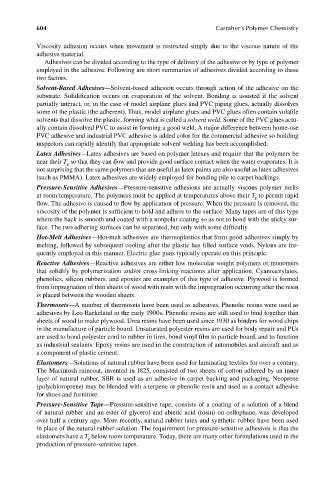Page 641 - Carrahers_Polymer_Chemistry,_Eighth_Edition
P. 641
604 Carraher’s Polymer Chemistry
Viscosity adhesion occurs when movement is restricted simply due to the viscous nature of the
adhesive material.
Adhesives can be divided according to the type of delivery of the adhesive or by type of polymer
employed in the adhesive. Following are short summaries of adhesives divided according to these
two factors.
Solvent-Based Adhesives—Solvent-based adhesion occurs through action of the adhesive on the
substrate. Solidification occurs on evaporation of the solvent. Bonding is assisted if the solvent
partially interact, or, in the case of model airplane glues and PVC piping glues, actually dissolves
some of the plastic (the adherent). Thus, model airplane glues and PVC glues often contain volatile
solvents that dissolve the plastic, forming what is called a solvent weld. Some of the PVC glues actu-
ally contain dissolved PVC to assist in forming a good weld. A major difference between home-use
PVC adhesive and industrial PVC adhesive is added color for the commercial adhesive so building
inspectors can rapidly identify that appropriate solvent welding has been accomplished.
Latex Adhesives—Latex adhesives are based on polymer latexes and require that the polymers be
near their T so that they can flow and provide good surface contact when the water evaporates. It is
g
not surprising that the same polymers that are useful as latex paints are also useful as latex adhesives
(such as PMMA). Latex adhesives are widely employed for bonding pile to carpet backings.
Pressure-Sensitive Adhesives—Pressure-sensitive adhesions are actually viscous polymer melts
at room temperature. The polymers must be applied at temperatures above their T to permit rapid
g
fl ow. The adhesive is caused to fl ow by application of pressure. When the pressure is removed, the
viscosity of the polymer is sufficient to hold and adhere to the surface. Many tapes are of this type
where the back is smooth and coated with a nonpolar coating so as not to bond with the sticky sur-
face. The two adhering surfaces can be separated, but only with some diffi culty.
Hot-Melt Adhesives—Hot-melt adhesives are thermoplastics that form good adhesives simply by
melting, followed by subsequent cooling after the plastic has filled surface voids. Nylons are fre-
quently employed in this manner. Electric glue guns typically operate on this principle.
Reactive Adhesives—Reactive adhesives are either low molecular weight polymers or monomers
that solidify by polymerization and/or cross-linking reactions after application. Cyanoacrylates,
phenolics, silicon rubbers, and epoxies are examples of this type of adhesive. Plywood is formed
from impregnation of thin sheets of wood with resin with the impregnation occurring after the resin
is placed between the wooden sheets.
Thermosets—A number of thermosets have been used as adhesives. Phenolic resins were used as
adhesives by Leo Baekeland in the early 1900s. Phenolic resins are still used to bind together thin
sheets of wood to make plywood. Urea resins have been used since 1930 as binders for wood chips
in the manufacture of particle board. Unsaturated polyester resins are used for body repair and PUs
are used to bond polyester cord to rubber in tires, bond vinyl film to particle board, and to function
as industrial sealants. Epoxy resins are used in the construction of automobiles and aircraft and as
a component of plastic cement.
Elastomers—Solutions of natural rubber have been used for laminating textiles for over a century.
The Macintosh raincoat, invented in 1825, consisted of two sheets of cotton adhered by an inner
layer of natural rubber. SBR is used as an adhesive in carpet backing and packaging. Neoprene
(polychloroprene) may be blended with a terpene or phenolic resin and used as a contact adhesive
for shoes and furniture.
Pressure-Sensitive Tape—Pressure-sensitive tape, consists of a coating of a solution of a blend
of natural rubber and an ester of glycerol and abietic acid (rosin) on cellophane, was developed
over half a century ago. More recently, natural rubber latex and synthetic rubber have been used
in place of the natural rubber solution. The requirement for pressure-sensitive adhesives is that the
elastomers have a T below room temperature. Today, there are many other formulations used in the
g
production of pressure-sensitive tapes.
9/14/2010 3:43:44 PM
K10478.indb 604 9/14/2010 3:43:44 PM
K10478.indb 604

